About Voynich Manuscript Letters
We have been conditioned to believe the VM is written in a code that most of the researchers ignored the possibility that the same letters were used in the European manuscripts, and that different nations adopted Latin letters for their sounds differently. Also, the idea of VM being a mysterious code has prompted all kinds of speculations, so that the more exotic theories gained more attention, simply because people wanted to see the mystery where there is none, and at the same time, most interpreters ignored the mystery in the VM, hidden in the images, by desperately trying to identify the flowers, the ‘castle’, or ‘the public baths’.
Assuming the researchers before me followed the logical way of thinking and developed their transliteration alphabet by comparing the letters to the medieval European scripts, I tried to transliterate some short words with EVA alphabet. To my surprise, I was able to recognize many Slovenian words, but there were some EVA-letters that did not suit Slovenian language, such as EVA ‘q’ which does not exist in Slovenian. After examining the documents written in the region of Slovenia in the 15th century, I developed an improved transliteration alphabet I call Slovenian Voynich Alphabet.
The first step in decoding the VM is to figure out where the author got the ideas for the shapes of the letters, and for what sounds he used them. This could be done by the process of comparison. For example, most German manuscripts use different shape of ‘z’ for Latin ‘c’, and for the sound ‘c’. They also combine ‘cz’ for the sound ‘c’. Although my first step was the recognition of Slovenian words when VM text was transcribed with EVA alphabet, I imagine this could not be the first step for those who want to replicate my theory and have no knowledge of Slovenian language, nor its dialects. Most German manuscripts use combination of letters ‘sw’, ‘su’, or ‘zw’, while these combinations are totally absent in the VM. Therefore, it is reasonable to conclude that the author of the VM invented two tall letters to replace those German combinations for the sounds ‘SV’, ‘CV’, ‘ZV’ (SW, CW, ZW). Because those letter combinations in the VM show some properties as the other two letters, the author of the VM invented (‘t’ and ‘k’) further supports transliteration of those glyphs. Also, those letter combinations are frequently used in Slovenian language and have a high symbolic value, since they can be found in words, such as ‘holy’, ‘divine’, ‘world’, ‘advice’, ‘criticism’, ‘flower’, ‘bell’, ‘star’, ‘light’, ‘enlightenment’ … These words which are most often found at the beginning of the VM paragraph, at times also embellished, must have been important to the author of the VM, as they would have been for any medieval spiritual writer.
Most VM researchers believe the VM letters are like Latin letters, yet nobody can read the text. A lot of distrust was created when it was suggested that the VM is written in a code, or in abbreviations, or shorthand. Also, the authors of EVA-alphabet never claimed that some of their transliteration letters are in fact Latin letters, leaving the would-be researchers to imagine any kind of script could be interpreted as VM letters, while EVA script was just there as a common denominator used for research and analysis. As it turns out, the computer analysis was of little help, because so far it was not able to detect the particulars of any language.
Like many VM researchers before me, I notice the similarity of some VM glyphs with the Latin letters, however the EVA-daiin word, probably the most frequently used word in the VM, seems to turn the attention from other possible readings. I instinctively read it as DAM. By then, Dr. Bax had also pointed out that the various combination of minims can be read as 14 different letters, producing different sounds. For me, it seemed natural to read the word DAIIN as DAM, and AIIN as AM. Changing EVA-m into IL (ILJ) produced another Slavic ending.
Based on the words I was able to recognize with the EVA alphabet alone, I used my knowledge of Slovenian language, and my intuition to develop my own translation alphabet which I validated by comparing the letters to the Stična Codex, written in Slovenian between 1428 and 1440, transcribed and translated by professional linguists. I also compared the shapes of the letters with various other 15th century documents written in Latin, or German in the region of the present-day Slovenia.
Since every writer has his own way of shaping the letters, I was only looking for a general shape, like ‘d’ looking like 8, ‘l’ with a loop, ‘i’ without a dot … I believe that many VM reserchers are too focused on finding the script that matches exactly the VM glyphs, that they miss what is most obvious. Not only the shapes of the letters, but the writing style (no capitalisation, no punctuation) conformed to the style of the comparative documents.
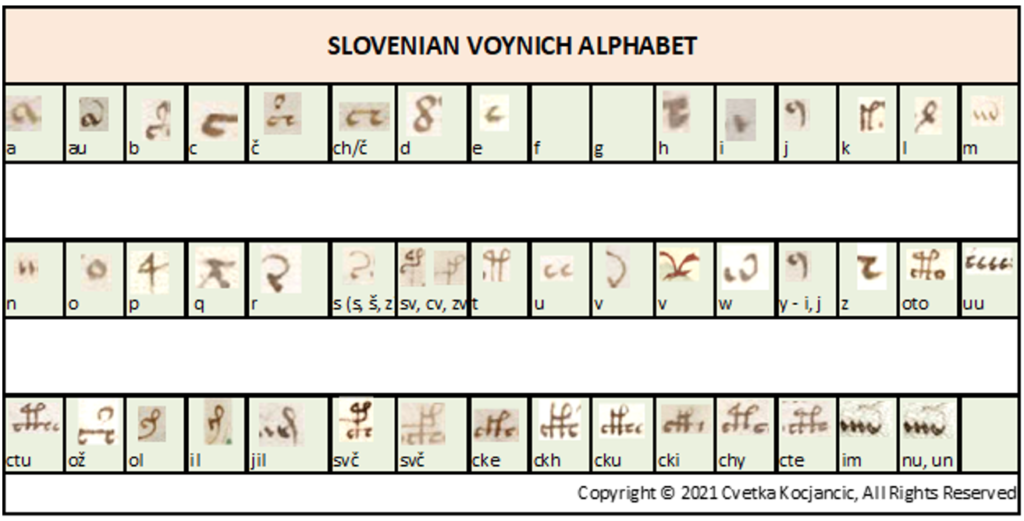
The modified alphabet I developed worked very well for Slovenian language, however, the VM is still hard to read because of unclear handwriting and complicated medieval Slovenian language.
The last row in above table was transliterated mostly on my common sense and the way the ligatures sounded when pronounced.
It did not bother me that the letters ‘f’ and ‘g’ seem to be missing in the VM. Dr. Timothy King, in his Venetic theory has also pointed out the missing G, which for him was an important clue that the VM might have been written in the Veneto region, since only that part of Italy did not use the letter G, just like some regions in present-day Slovenia and Croatia. The absence of the letter F could be explained with two VM letters that sound like F – SV and V. While in Latin, the letter V stood for the sound U, in German writing, it often stands for the sound F.
Although my transliteration alphabet worked very well for the Slovenian language; convincing the experts is another story. I had offered the VM experts my explanation of grammatical peculiarities that could only be comparable to Slovenian language, such as various grammatical endings for different conjugations and declinations, tenses, numbers, and genders, but I was totally ignored. I realized that even if I presented total transcription and translation of the VM, I would not be able to convince any experts, because they already have a preconceived idea that the mystery of the Voynich Manuscript cannot be solved by ‘a grandma’, since many academics have tried and failed.
I suppose, my age gives me advantage many young scholars do not have: I learned how to write with a still ‘fedder’ (a little improvement from a goose fedder) that had to be dipped into ink, and I know how this can produce unintentional thick or thin lines. I also know how writing by a dim candlelight in a freezing cold room can effect handwriting. And, yes, living in a village where compulsory school was not introduced until the mid-19th century, I spoke a peasant Slovenian dialect which in the past half-century had been forcefully eliminated in an effort to make people use common literary language.
On another hand, my immigration to Canada opened new possibilities for me. I studied psychology at the university level and later researched on my own the interconnectedness between art, religion, and psychology, which have common mystical religious denominator. In my creative writing, I focused mainly on life-stories of Slovenian immigrants in Canada, and in the process, I learned a lot about various Slovenian dialects they spoke, as well as about their unique lives and interests. So, in a way, I am in a better position to analyze the VM from different perspectives, than a group of experts all focusing on their own area of expertise, not knowing how the parts are blended, not just interconnected.
Another preconceived idea repeated countless times by the VM researchers pertains to the content of the VM, based on the general thematical sections of the manuscript. Those who play to these preconceived ideas (writing on astrology, women’s health, description of healing plants and usefulness of the roots and leaves, five different scribes, etc.) are receiving much more attention, even if their theories are unreasonable and less likely correct. Although various VM researchers concluded that the VM was created somewhere in southern Germany, northern Tyrol, or Northern Italy, my theory is mostly ignored, even if it fits that geographical region, and the style of the manuscripts written in Alsace.
One of the conditions for the correct solution of the VM is the question of replicability. Those who leave themselves a lot of freedom to interpret the VM words in many different ways, can come with some kind of solution, but nobody else could come up with the same reading, or with the same translation.
STEP BY STEP REPLICATION
How could my theory be replicated?
To prove that my theory can be replicated, I replicated it myself, using different manuscripts to devise the transcription alphabet.
In 2021, when more manuscripts were digitalized and placed online, I have chosen several 15th century manuscripts in different languages to compare the shapes of the Latin letter to the shapes of the VM, as well as for their use for different sound. The result enabled me to verify the transcription alphabet I had developed, to compare the style of writing, as well as the topics of the medieval manuscripts.
The manuscripts used:
- Tractatus de Husitis, written in Latin between 1428 and 1450 in Stična, Slovenia, by a Czech monk;
- Golden Legend, Czech translation of the original Latin work;
- The Alphabetarium divini amoris, written by Johannes Nyder in Carthusian monastery Pleterje in 1425;
- Regiment of Helath, in German, written in 1429 by Heinrich von Laufenberg.
- COD PAL German 291
Tractatus de Husitis
My original VM alphabet is based on EVA with some changes and better identification of minims, which I was able to do by comparing the VM writing with the Stična Codex, written in Stična. The Tractatus de Husitis was written about the same time, in the same monastery, and most likely by the same author who wrote Stična Codex in Slovenian. In Stična Codex, the end-minims have a downward tail, while in Tractatus, the flourishes are turned upwards over one, two, or three minims. Minims are pointy, and the hairline diagonal connecting line is hardly visible.

The Golden Legend is the 15th century Czech version of the Golden Legend written in Latin by Jacobus de Voragine in the mid-13th century. It contains a collection of the legends of the lives of the saints.
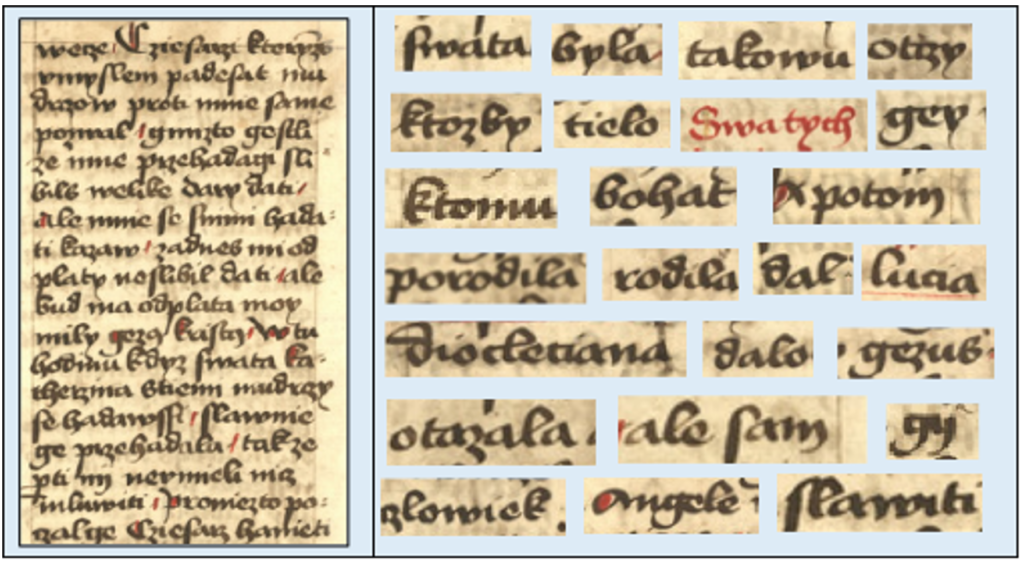
From the Golden Legend I obtained clear understanding how the letter ‘h’ was used instead of ‘g’ (based on pronunciation), while the letter ‘g’ was used for the sound ‘j’. I was also able to make distinctions between the Czech and the Slovenian language. Because the Slavic languages used common Old Church Slavonic language in liturgy, there was a lot of similarity in grammar and in vocabulary, yet there are also many differences, so that I was able to discard Czech as the language of the VM.
Since this manuscript contains the legends of the lives of some saints, it can be concluded that it was written by the Roman Catholic interpretation of mystical visions of Mary and angles, which seem to be absent in the VM.
The Alphabetarium divini amoris was written in 1425 by Johannes Nyder in Carthusian monastery Pleterje. Although it is written in Latin, I was able to find several letters that are not included in Latin alphabet, such as w, k, u, r (like the VM), 8-like ‘d’, and in a few cases also the 9-shaped ‘y’. Various Latin abbreviations are also used, including 9-shape for Latin abbreviations ‘con-‘ and ‘-us’. Even without knowing Latin, I was able to recognize many words.
This manuscript was particularly helpful to me for various reasons. It was written by a Swabian theologian John Nider (Nyder). Nider was one of the most famous German preachers. He studied philosophy in Vienna. He was very active at the Council of Constance, spent some time at Carthusian monastery at Pleterje and in 1425 returned to the University of Vienna where he taught Theology. This would coincide with the time Nicholas Kempf was a student or a teacher at the Vienna University. Nider is known as early reformer. As an active member of the Coucil of Basel, he made great contribution to reconciliation with the Bohemians. He remained loyal to the Council of Basel even after Pope Eugene IV disolved the Council.
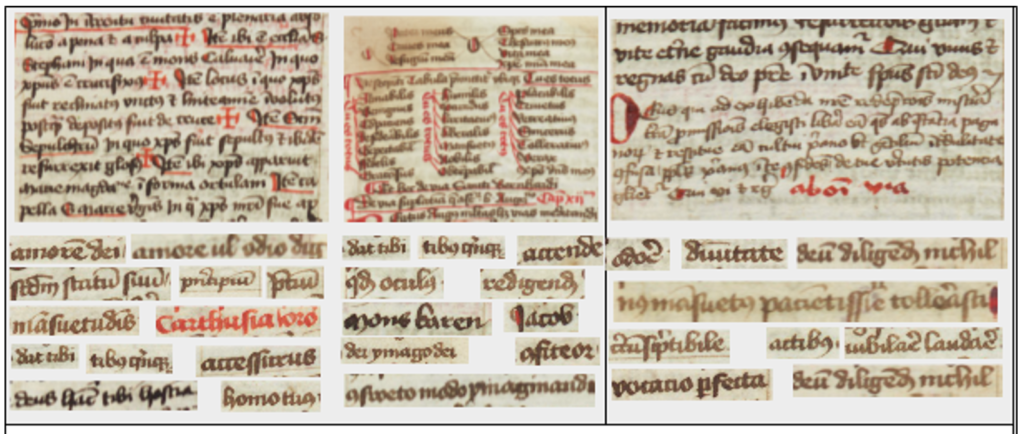
This manuscript revealed the similarity of the cursive writing, as well as the philosophy Kempf would adhere to, for Nider was his professor, and later his fellow faculty member at the Vienna University. Kempf could also have seen this manuscript at the Charterhouse of Pleterje. Assuming that Kempf was the author of the VM, he would have been influenced by Nider’s preaching about the divine love that leads to mystical religious experience, and his political views supporting the Church reforms. This views seem to be reflected in the illustrations of the Voynich Manuscript.
Regimen Sanitatis (Regiment of Health), written by Heinrich von Laufenberg in 1429, was chosen for my comparison because of the script, as well as its content, and its possible connection to Nicholas Kempf. The manuscript is written in a popular genre of German Housebuchs. It is a rework of the 12th century work Flos medicinae, or the Flower of Medicine, believed to be written by John of Milan, and edited by Arnold of Vollanova, physician, alchemist, astrologer, and religious reformer. Arnold is also regarded as the author of the Rosarius Philosophorum, which reappeared as a Rosicrucian manifesto in the 17th century.
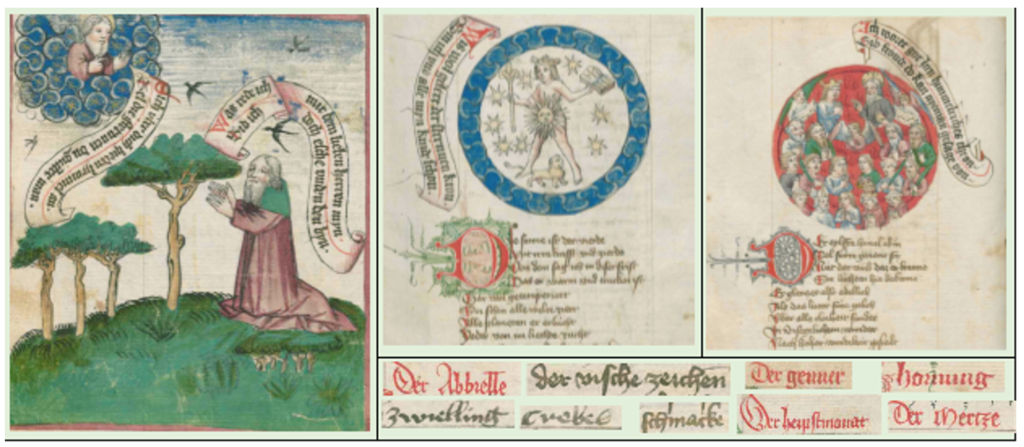
This manuscript was very helpful to me for understanding the Voynich Manuscript from different perspectives. The ‘b’ is occasionally used for ‘p’, ‘v’ for ‘f’, ‘sch’ for š (sh), ‘z’ or ‘cz’ for ‘c’, ‘g’ for ‘j’ (in the word January), ‘h’ or ‘ch’ for ‘h’, two shapes of ‘r’ are used (one like the Latin ‘r’, and one like VM-r, except smaller, ‘cv’ or ‘zw’ is used for the sounds ‘cv’ or ‘zv’). Also, two shapes of ‘d’ are used, one with two loops, and one with only the bottom loop.The letter ‘e’ already has a horizontal line.
It has been pointed out by some VM researchers that the VM might be thematically related to the German Housebuchs. Like the Housebuchs, VM contans the Astrological section with zodiac images, the bathing scenes, and the claudbands, the use of concentrical circles, the Sun and Moon have a prominent place, so do stars, the zodiac symbols show unique interpretation. Unlike the Housebuch, VM does not have a calendar, nor astrological calculations and images of the planets. The VM also contains large plant section, which cannot be found in any housebuch I examined.
The COD. Pal German 291 is another so called Iatromathematische Housebuch. It is very similar to the Regiment of Health, particularly the illustrations. Nick Pelling, the well known VM researcher, suggested that the family of the Housebuchs could lead to solving the VM mystery.
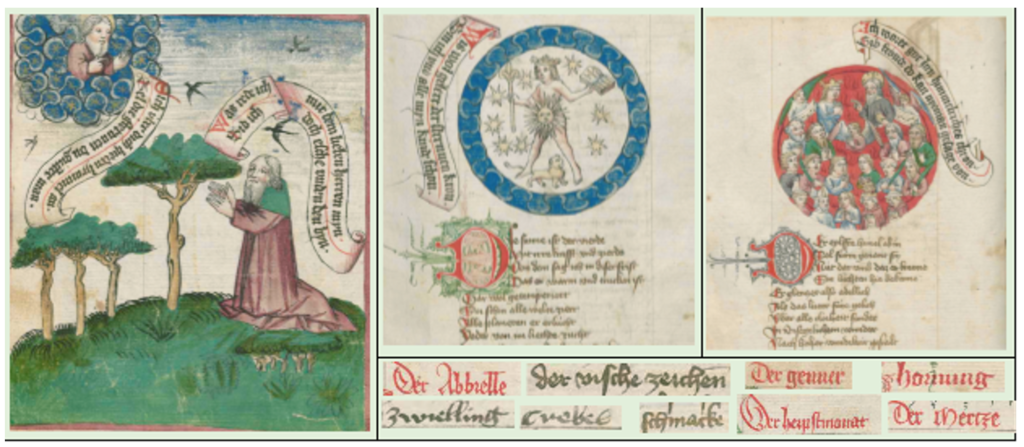
The manuscript is beautifully illustrated with a lot of dark blue colours, golden stars.
The manuscript is written in German, but the word ‘Oratio’ is used consistently for prayer. The ‘heiligen namen’ is mentioned. The contemplation about the biblical writing (epistels) is urged. The temple seems to be the natural environment.
There are some minor differences in the shapes of the letters, which are very important for the understanding of the VM. The letters are writtten tightly together, so that ‘cke’, ‘cti’ look somewhat like the VM strike-through glyphs. The small VM-like ‘r’ is used interchengeably with a regular Latin ‘r’.
Most male names of the saints end with -i, not with latin -us (Maximiliani, Sixti pape, Alexy. The letter ‘p’ is often used for ‘b’ sound ( geporn- born, Stampock – capricorn, Scorpion – Scorpion).
This manuscript shows great likeness to the Regiment of Health: a lot of stars, cloudband, similarity of zodiac signs and signs for constellations, as well as the images of personality types. Like other Housebuchs, this, too, contains the image of a ‘planetman’, suggesting that the author believed in influence of the personality of children born under different zodiac signs.
Like the Regiment of Health, Cod. Pal 291 contains two sets of Zodiac signs (one on earth, one in heaven- spiritual world).
The book also contains prayes and at the end, there seems to be a legend about a Fox. I never learned enough German to try to translate this text; however I have a distinct feeling the legend is about the Wolf and a Fox (since this is not related to the script, but rather to the folk-legends circulating at the time, I will discuss it elsewhere).
The Planeten Buch – BSB Cgm 7269, Konstanz is beautifully illustrated. Humans are wearing European fashion and European physical features. The Acquarius, looking like a man from Styer – wearing black hat and an apron, is pouring water from the wooden bucket.
The script is similar to the script of other German manuscripts. I have found similar scripts in different manuscripts not listed here. The VM-r, which is hard to find in the 15th cenuty scripts (due to its small size and similarity to theletter ‘z’, can also be found in a small folding calendar, now stored in the NUK (National University Library) in Ljubljana. The pictures in that callendar also show a lot of similarity to VM drawing of faces.
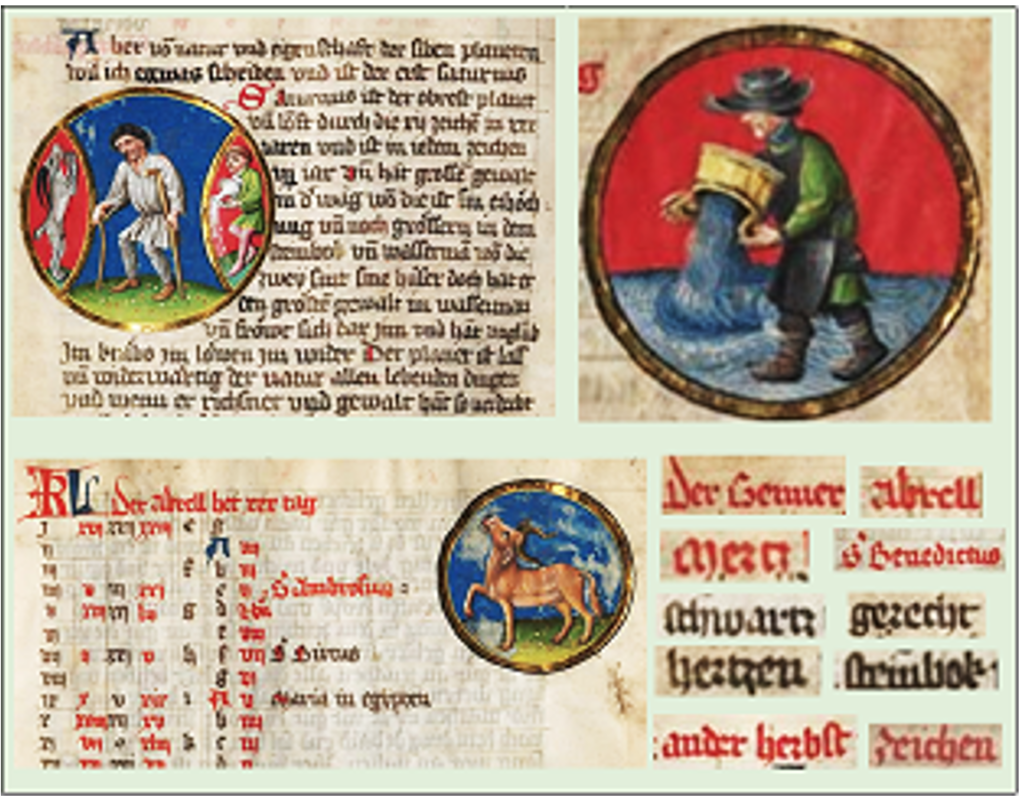
Conclusion
Assuming that Nicholas Kempf was the author of the VM, he could have had a chance to get acquainted with all the manuscripts mentioned above, and the ideas presented in those books. Judging by the VM illustration, the author of the VM did not believe in planetary effects on human personality, but rather on the influence of important historical persons, and particularly on what one reads and how he interprets what he reads.
My new search for transliteration alphabet, using five different manuscripts in different languages confirmed the correctness of the Slovenian Voyhnich Alphabet I had developed, based on the 15th century documents from the Slovenian region only. Expect for the four tall VM letters (Gauge glyphs) and perhaps the letter ‘p’, all other letters could be recognized as regular Latin letters used in different combinations for different sounds. There might not be all in one manuscript, but they can be found in the general area and in the books, my proposed author of the VM, Nicholas Kempf, could have an opportunity to see. Some leters were used for one sound in one language and for another in another language, however, all represent the languages and scripts that influenced Slovenian language and orthography. In the new alphabet comparison table, I have marked the letters that represent the same sound, in light blue, and the ones that could stand for two or three different sounds, or for different sounds in different languages, I marked with the dark blue. I will discuss those in greater detail later.
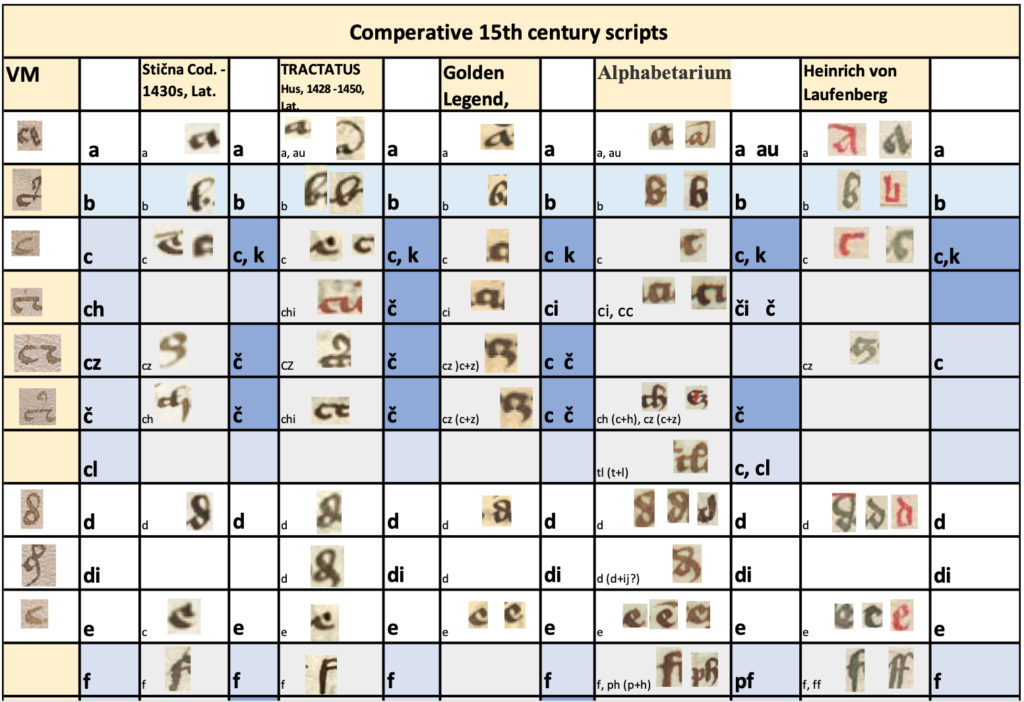
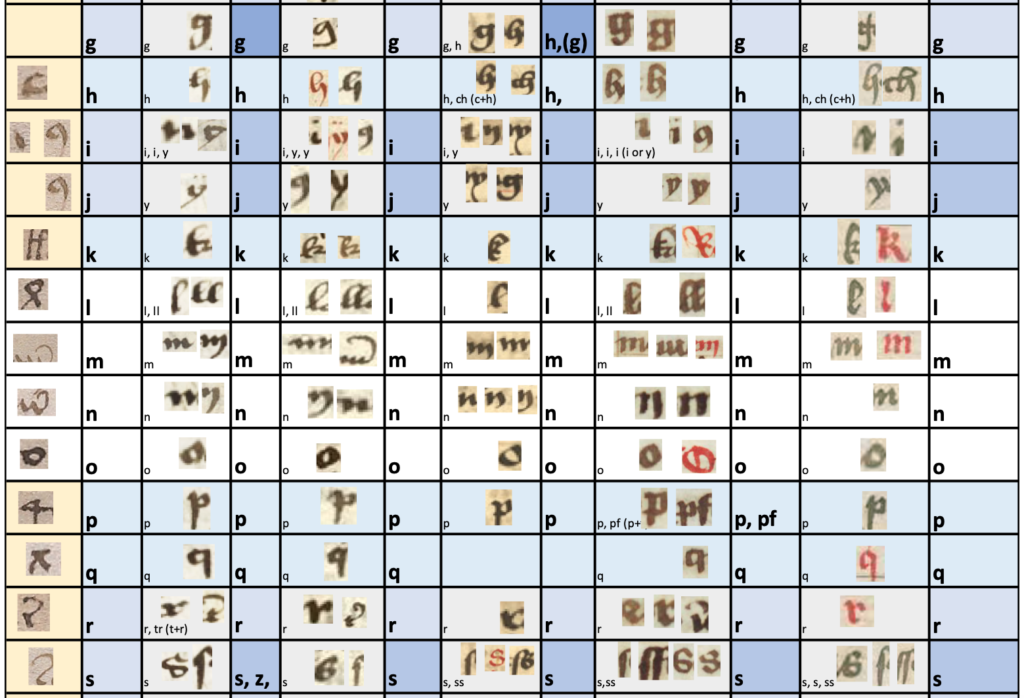
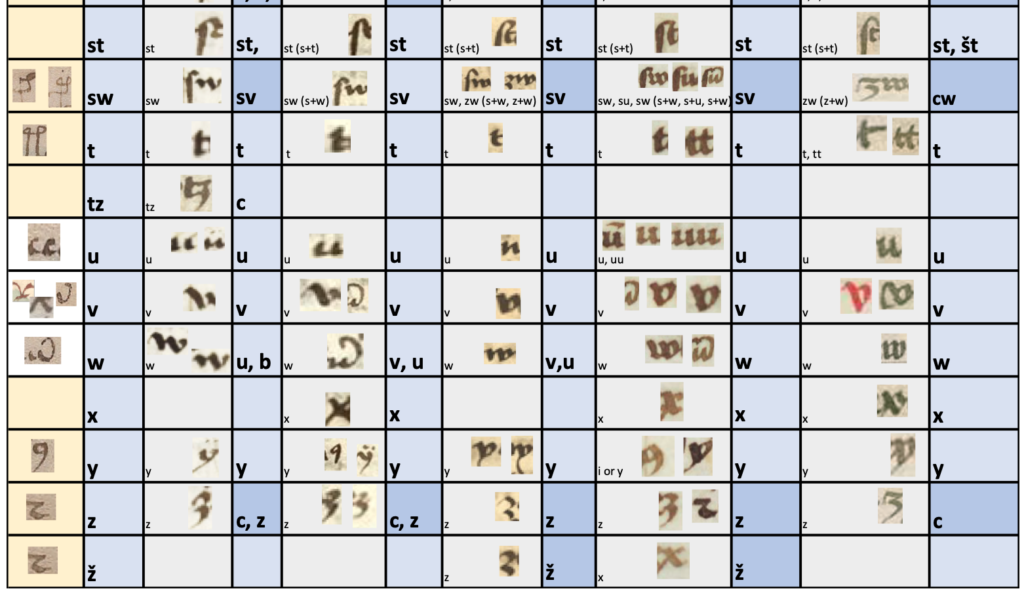
Several VM researchers, among them Dr. Rene Zandbergen from Germany, the great authority on the VM, had proposed the Southern Germany or Northern Italy as a location of the VM origin.
Aga Tenktakulus, a chemical engineer from Switzerland, focusing on identifying the VM plants, has agreed that Slovenia (medieval Carniola) would fit into his proposed location. On his post in January 2021, he wrote the following: “For those who think it might be an old Slavic in the VM, yes. All the clues would coincide in the green circle. It is called the Duchy of Carniola, from 1365 a territory of the Habsburgs.”
Dr. King from Kensas University proposes the Vulgar Latin language is Italian dialect of Veneto region. He pointed out that he identified this region because of the absence of double letters, and the absence of the letter G in the VM. I suppose he and his team identified the Slovenian dialect of the Veneto language, however, using the wrong transliteration alphabet, they could not come up with Slovenian words, and the Latin words are only approximate (not even one is letter-to-letter transliteration and translation).
Based on his own research of the VM script and illustrations, J. K. Petersen narrowed the region where he thinks the VM was created to a village of Timau (once known as Teschelwang), north-east of Veneto, where Tischlbong language was spoken. He pointed out that a language is related to Carinthian “a south-Bavarian dialect spoken by Slovenes who inhabit the mountains of the southern Tyrol and parts of the Slovenian Styria” and that “as a distinct dialect, Carinthian dates to about the end of the 13th century”.
Considering all this, I am surprised that the other VM researchers are so reluctant to focus their research on Slovenian language.
In my next post, I will list 80 Slovenian words found in the VM that can be transliterated letter-to-letter and easily translated by any Slovenian speaking person (less likely by Google translate, because it does not consider Slovenian grammar). The transliteration can be replicated by using my Slovenian Voynich Alphabet to transcribe the listed words into Voyniches, or from Voyniches to Slovenian.
******SEE INTRODUCTION ARTICLE OF THE PROJECT VOYNICH MANUSCRIPT SLOVENIAN MYSTERY EXPLAINED AT: https://voynichslovenianmystery.com/?page_id=9
********BASICS: https://voynichslovenianmystery.com/
3 replies on “VM for Replication Part 1”
Top ,.. top top … post! Keep the good work on !
Top site ,.. amazaing post ! Just keep the work on !
Top site ,.. i will save for later !